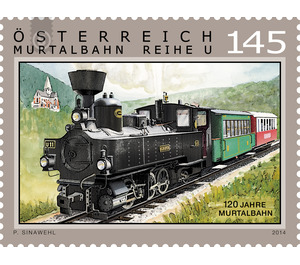120 years - Austria / II. Republic of Austria 2014 - 145 Euro Cent
Theme: Traffic, Transportation & Mobility
| Country | Austria / II. Republic of Austria |
| Issue Date | 2014 |
| Face Value | 145.00 |
| Edition Issued | 230,000 |
| Printing Type | Combination printing, offset stitch (Etch-Art by OeSD) |
| Stamp Type | Commemorative |
| Item Type | Stamp |
| Chronological Issue Number | 2500 |
| Chronological Chapter | OOS-OE2 |
| SID | 394142 |
| In 69 Wishlists | |
For 120 years the Murtalbahn steams and snorts along the green Mur from Unzmarkt to Tamsweg. Already Emperor Franz Joseph frequented the romantic narrow-gauge railway to hunt chamois in Murau - today the Murtalbahn offers not only modern and scheduled passenger transport but also nostalgic excursions and unforgettable impressions of Upper Styria and eastern Salzburg. In 1892, the construction of a railway line from Unzmarkt to Mauterndorf was decided by the Styrian Parliament - on August 27, 1893, the groundbreaking ceremony took place. In just over a year, the Murtalbahn was built, which included twelve stations, fourteen stops and seven water stations to supply the steam locomotives. For the communication of the trains and stations instead of the then usual Morsetelegrafen for the first time telephones were used. The ceremonial opening of the narrow-gauge railway with a gauge of 760 millimeters took place on 8 October 1894. Although the first few years did not go as promising as hoped, freight traffic, which consisted mainly of timber transports, soon increased. Private travel to Murau also increased significantly. The First World War meant a slump for the railway, and the global economic crisis caused setbacks. In the Second World War, passenger traffic increased sharply, the Murtalbahn was largely spared war damage. In the 1950s, there was an economic boom, and Austria was hit by a motorization wave. This meant great competition for the railway, which in turn also came up with some renewals and improvements: until 1967, for example, the steam locomotives were replaced by diesel-powered tractors. Already a year later, however, they remembered the nostalgic steam locomotives and offered first slow-moving, which are still a fixed part of the timetable. In 1969 amateur rides were introduced, which have since made the hearts of railroad friends beat faster. Since the beginning of the 1970s, the saloon cars "Murtalbar" and "Steirerbar" provide the culinary well-being of the excursion guests. Although the Tamsweg-Mauterndorf section had to be abandoned in 1982, the introduction of innovative narrow-gauge railcar helped the Murtalbahn to prevail against the increasing car and bus traffic - today, the Murtalbahn transported around 430,000 passengers on its 65 kilometers per year. The steam locomotive U 11 presented on the special stamp was produced in 1894 by the Linz company "Krauss & Cie" and is still in full use. The locomotive also called "Mauterndorf" reaches a top speed of 45 km / h and is owned by the Styrian Provincial Railways. The narrow-gauge steam locomotives of the type "U" are the most widely used in Austria due to the powerful boilers and their good running characteristics.


